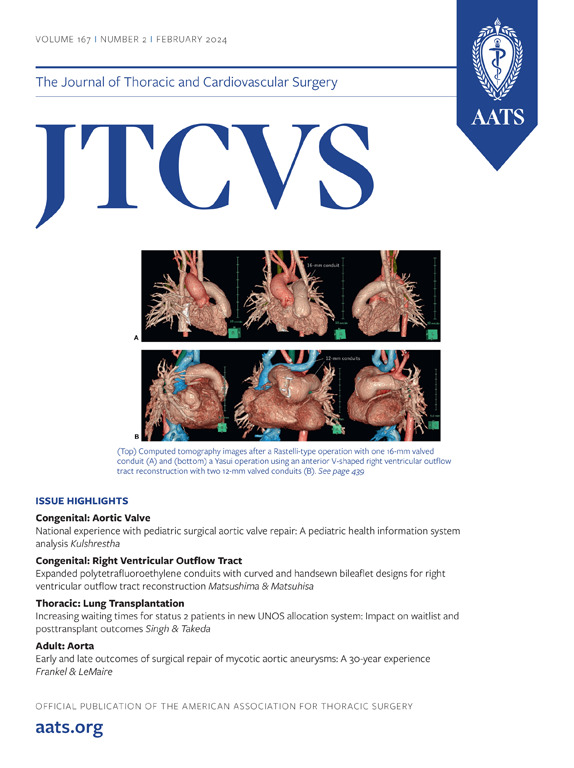在一家大型左心室辅助装置中心验证 HeartMate 3 生存风险评分。
IF 4.9
1区 医学
Q1 CARDIAC & CARDIOVASCULAR SYSTEMS
Journal of Thoracic and Cardiovascular Surgery
Pub Date : 2025-02-01
DOI:10.1016/j.jtcvs.2024.03.009
引用次数: 0
摘要
目的:HeartMate 3生存风险评分最近在 "MagLev技术在使用HeartMate 3进行机械循环支持治疗的患者中的多中心研究 "中得到验证,用于预测HeartMate 3左心室辅助装置候选患者的特定生存率。HeartMate 3 生存风险评分根据生存概率将个体分为三等分:我们对2017年9月至2022年8月期间所有HeartMate 3左心室辅助装置接受者进行了单中心回顾性研究。我们从电子病历中收集了基线特征。计算了所有符合条件的患者的 HeartMate 3 生存风险评分。进行了一年和两年的卡普兰-梅耶生存分析。采用单变量和多变量考克斯回归模型确定预测因素:共有 181 名患者被纳入最终分析。中位年龄为 62 岁,83% 为男性,26% 为机构间机械辅助循环支持注册资料 1。整个队列的平均 HeartMate 3 生存风险评分为 2.66 ± 0.66。高存活率组、平均存活率组和低存活率组的两年存活率分别为 93.5% ± 3.2%、81.6% ± 7.4% 和 82.0% ± 6.6%。作为连续变量,未经调整的 HeartMate 3 生存风险评分可显著预测死亡率(危险比为 2.20;95% CI 为 1.08-4.45;P = .029)。1 年和 2 年的曲线下面积分别为 0.70 和 0.66。使用原始分层法时,我们无法证明 HeartMate 3 生存风险评分的鉴别能力,但使用二元截断法时,我们发现高生存率组的生存率显著增加(危险比,4.8;95% CI,1.01-20.9;P = .038):结论:未经调整的HeartMate 3存活风险评分与MagLev技术在使用HeartMate 3接受机械循环支持治疗的患者中的多中心研究外的患者植入后存活率有关,但在调整缺血病因和严重糖尿病后,该评分不再是独立的预测因素。HeartMate 3存活风险评分能够通过二元截点识别高存活率患者,但我们无法证明它在之前公布的风险分级中的鉴别能力。本文章由计算机程序翻译,如有差异,请以英文原文为准。
Validation of the HeartMate 3 survival risk score in a large left ventricular assist device center
Objective
The HeartMate 3 survival risk score was recently validated in the Multicenter study Of MagLev Technology in Patients Undergoing Mechanical Circulatory Support Therapy with HeartMate 3 to predict patient-specific survival in HeartMate 3 left ventricular assist device candidates. The HeartMate 3 survival risk score stratifies individuals into tertiles according to survival probability.
Methods
We performed a single-center retrospective review of all HeartMate 3 left ventricular assist device recipients between September 2017 and August 2022. Baseline characteristics were collected from the electronic medical records. HeartMate 3 survival risk scores were calculated for all eligible patients. One- and 2-year Kaplan–Meier survival analyses were conducted. A univariate and multivariable Cox regression model was used to identify predictors.
Results
A total of 181 patients were included in this final analysis. The median age was 62 years, 83% were male, and 26% were Interagency Registry for Mechanically Assisted Circulatory Support Profile 1. The mean HeartMate 3 survival risk score for the entire cohort was 2.66 ± 0.66. Two-year survivals in the high, average, and low survival groups were 93.5% ± 3.2%, 81.6% ± 7.4%, and 82.0% ± 6.6%, respectively. As a continuous variable, the unadjusted HeartMate 3 survival risk score was a significant predictor of mortality (hazard ratio, 2.20; 95% CI, 1.08-4.45; P = .029). The areas under the curve were 0.70 and 0.66 at 1 and 2 years, respectively. We were unable to demonstrate the discriminatory ability of the HeartMate 3 survival risk score using the original stratification, but we found significantly increased survival in the high survival group using a binary cutoff (hazard ratio, 4.8; 95% CI, 1.01-20.9; P = .038).
Conclusions
The unadjusted HeartMate 3 survival risk score was associated with postimplant survival in patients outside of the Multicenter study Of MagLev Technology in Patients Undergoing Mechanical Circulatory Support Therapy with HeartMate 3 but did not remain an independent predictor after adjusting for ischemic etiology and severe diabetes. The HeartMate 3 survival risk score was able to identify patients at high survival using a binary cutoff, but we were unable to demonstrate its discriminatory ability among the previously published risk tertiles.
求助全文
通过发布文献求助,成功后即可免费获取论文全文。
去求助
来源期刊
CiteScore
11.20
自引率
10.00%
发文量
1079
审稿时长
68 days
期刊介绍:
The Journal of Thoracic and Cardiovascular Surgery presents original, peer-reviewed articles on diseases of the heart, great vessels, lungs and thorax with emphasis on surgical interventions. An official publication of The American Association for Thoracic Surgery and The Western Thoracic Surgical Association, the Journal focuses on techniques and developments in acquired cardiac surgery, congenital cardiac repair, thoracic procedures, heart and lung transplantation, mechanical circulatory support and other procedures.

 求助内容:
求助内容: 应助结果提醒方式:
应助结果提醒方式:


